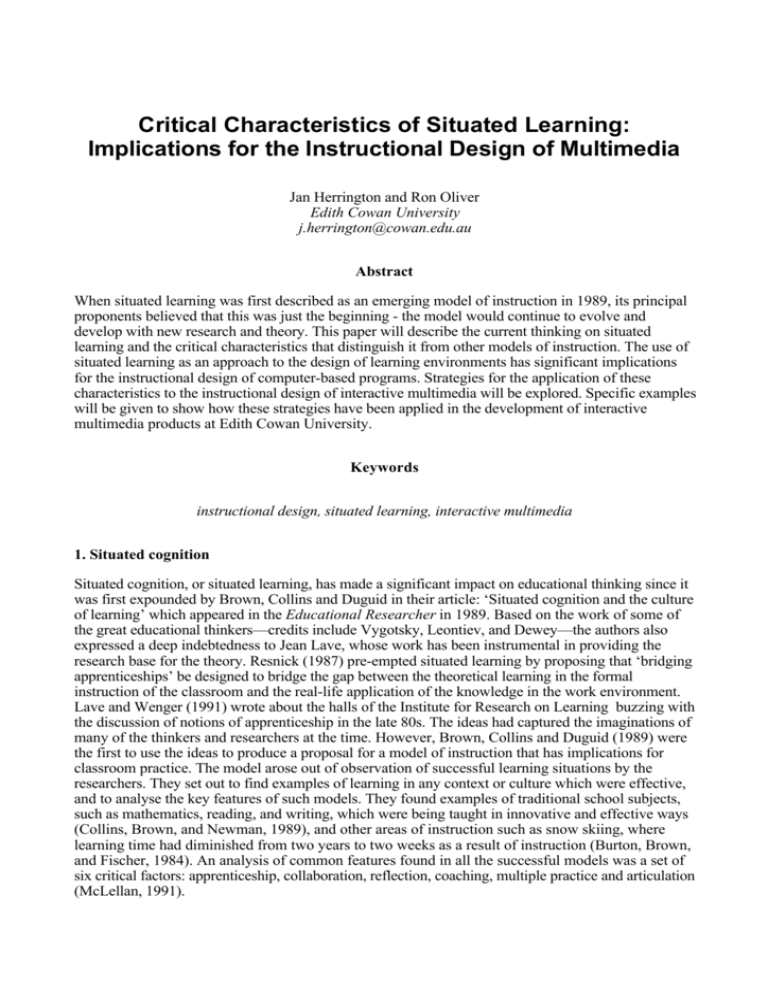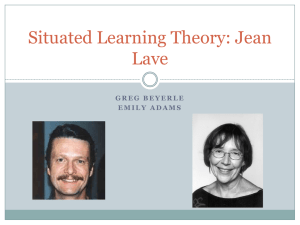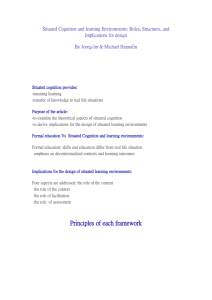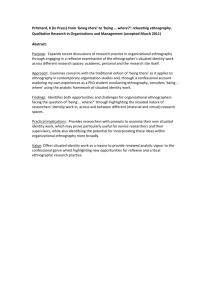Critical Characteristics of Situated Learning
advertisement

Critical Characteristics of Situated Learning: Implications for the Instructional Design of Multimedia Jan Herrington and Ron Oliver Edith Cowan University j.herrington@cowan.edu.au Abstract When situated learning was first described as an emerging model of instruction in 1989, its principal proponents believed that this was just the beginning - the model would continue to evolve and develop with new research and theory. This paper will describe the current thinking on situated learning and the critical characteristics that distinguish it from other models of instruction. The use of situated learning as an approach to the design of learning environments has significant implications for the instructional design of computer-based programs. Strategies for the application of these characteristics to the instructional design of interactive multimedia will be explored. Specific examples will be given to show how these strategies have been applied in the development of interactive multimedia products at Edith Cowan University. Keywords instructional design, situated learning, interactive multimedia 1. Situated cognition Situated cognition, or situated learning, has made a significant impact on educational thinking since it was first expounded by Brown, Collins and Duguid in their article: ‘Situated cognition and the culture of learning’ which appeared in the Educational Researcher in 1989. Based on the work of some of the great educational thinkers—credits include Vygotsky, Leontiev, and Dewey—the authors also expressed a deep indebtedness to Jean Lave, whose work has been instrumental in providing the research base for the theory. Resnick (1987) pre-empted situated learning by proposing that ‘bridging apprenticeships’ be designed to bridge the gap between the theoretical learning in the formal instruction of the classroom and the real-life application of the knowledge in the work environment. Lave and Wenger (1991) wrote about the halls of the Institute for Research on Learning buzzing with the discussion of notions of apprenticeship in the late 80s. The ideas had captured the imaginations of many of the thinkers and researchers at the time. However, Brown, Collins and Duguid (1989) were the first to use the ideas to produce a proposal for a model of instruction that has implications for classroom practice. The model arose out of observation of successful learning situations by the researchers. They set out to find examples of learning in any context or culture which were effective, and to analyse the key features of such models. They found examples of traditional school subjects, such as mathematics, reading, and writing, which were being taught in innovative and effective ways (Collins, Brown, and Newman, 1989), and other areas of instruction such as snow skiing, where learning time had diminished from two years to two weeks as a result of instruction (Burton, Brown, and Fischer, 1984). An analysis of common features found in all the successful models was a set of six critical factors: apprenticeship, collaboration, reflection, coaching, multiple practice and articulation (McLellan, 1991). In proposing their model of situated cognition, Brown, Collins and Duguid (1989) argued that meaningful learning will only take place if it is embedded in the social and physical context within which it will be used. Formal learning is often quite distinct from authentic activity, or ‘the ordinary practices of the culture’(p. 34). Many of the activities undertaken by students are unrelated to the kind performed by practitioners in their everyday work. A means of achieving authenticity, they proposed, was the model of cognitive apprenticeships, a method designed to ‘enculturate students into authentic practices through activity and social interaction’, and based on the successful and traditional apprenticeship model (Brown, Collins and Duguid, 1989, p. 37). A critical aspect of the situated learning model is the notion of the apprentice observing the ‘community of practice’. Lave and Wenger (1991) proposed that participation in a culture of practice can, in the first instance, be observation from the boundary or ‘legitimate peripheral participation’. As learning and involvement in the culture increase, the participant moves from the role of observer to fully functioning agent. Legitimate peripheral participation enables the learner to progressively piece together the culture of the group and what it means to be a member. ‘To be able to participate in a legitimately peripheral way entails that newcomers have broad access to arenas of mature practice’ (Lave and Wenger, 1991, p. 110). While the theories that underpin the notion of situated learning are relatively easily explained, implementing these ideas in instructional settings can pose particular problems. There are many questions that are raised in terms of the nature and form of the instruction when one attempts to construct learning environments that employ the principles and elements described by the proponents of situated learning theories. 2. Situated learning as a model of instruction The literature reveals a number of case studies, and some research, that support the contention that the situated learning approach can be used successfully as a model of instruction (e.g., Griffin, 1995; Bransford, Sherwood, Hasselbring, Kinzer, and Williams, 1990; Bransford, Vye, Kinzer and Risko, 1990; Cognition and Technology Group at Vanderbilt [CTGV] , 1990, 1993a, 1993b; Young, 1993). While the publication of the model of situated learning has met with much interest and acclaim, for example Farnham-Diggory (1992) wrote that the model ‘will be recognised as a genuinely new educational model ... I believe it is where contemporary scientific principles lead us’ (p. 558), it has also been widely debated and questioned. Several critics argued that situated learning requires that learners be exposed to ‘masters’ or experts in the practice of their trade and therefore it cannot be, by its very definition, transferred to the classroom (Tripp, 1993; Wineburg, 1989). Computer-based applications are a further step removed from real life work situations, and criticisms have been levelled at computer-based materials that claim to use a situated learning framework in their design. For example, Hummel (1993) maintained that ‘instructional designers who apply situated learning theory by implementation in electronic media should realize that they take an important step away from this theory ... courseware becomes the learning environment and not the authentic situation’ (p. 15). There is increasing agreement, nonetheless, that computer-based representations and ‘microworlds’ do provide a powerful and acceptable vehicle for the critical characteristics of the traditional apprenticeship to be located in the classroom environment. For example, Harley (1993) supports the potential of educational technology to bring situated learning within the reach of the student in the classroom, particularly through developments in virtual reality and hypermedia. Reeves (1993) considers that one of the major benefits of a well designed interactive multimedia environment is its ability to include ‘opportunities for simulated apprenticeships as well as a wealth of learning support activities’ (p. 107). Collins (1988) notes that ‘computers give us enormous power to create situated learning environments where students are learning about reading, writing, math, science and social studies in ways that reflect the kinds of activities they will need these for’ (p. 3). Many other writers and researchers (e.g., Jonassen, Mayes, and McAleese, 1993; Young, 1995; Zucchermaglio, 1993; CTGV, 1993c; McLellan, 1991; Klein and Hoffman, 1993; Bransford, Vye, Kinzer and Risko, 1990; Chiou, 1992) see a role for computer-based technologies in the fostering of apprenticeship-style learning in schools. Many of the researchers and teachers exploring the model of situated learning have accepted that the computer can provide an alternative to the real-life setting, and that such technology can be used without sacrificing the authentic context which is such a critical element of the model. McLellan (1994) sums up these approaches by pointing out that while knowledge must be learned in context according to the situated learning model, that context can be: (1) the actual work setting; (2) a highly realistic or ‘virtual’ surrogate of the actual work environment; or (3) an anchoring context such as a video or multimedia program (p. 8). Brown, Collins and Duguid, have consistently argued that their theory, when further researched and developed, would produce a model of instruction with practical classroom applications (Brown, et al., 1989; Collins, Brown and Newman1989; Collins, 1988). Their original article presented a nascent theory of situated learning. From the start, they suggested that their model was an attempt to begin the process of developing a theoretical perspective for successful learning which cognitive science had not, to date, been able to explain. The challenge put to researchers was to identify the critical aspects of situated learning to enable it to translate into teaching methods which could be applied in the classroom. Although McLellan (1994) summarises the key components of the situated learning model as: ‘apprenticeship, collaboration, reflection, coaching, multiple practice, and articulation of learning skills’(p. 7), the contributions of various theorists and researchers, including the original authors of the model, have expanded and refined the notion to a much more comprehensive and far-reaching framework for the design of learning environments. 3. What are the critical characteristics of situated learning for instructional design? A critical reading of the principal theorists (and critics) of situated learning reveals a number of important characteristics which have added to the evolving theory of situated learning, and an attempt has been made here to distinguish those features. Many of these authors believe that useable knowledge is best gained in learning environments which feature the following characteristics. The learning environments will: • Provide authentic context that reflect the way the knowledge will be used in real-life; • Provide authentic activities; • Provide access to expert performances and the modelling of processes; • Provide multiple roles and perspectives; • Support collaborative construction of knowledge; • Provide coaching and scaffolding at critical times; • Promote reflection to enable abstractions to be formed; • Promote articulation to enable tacit knowledge to be made explicit; • Provide for integrated assessment of learning within the tasks. 4. How can these critical characteristics be applied to the design of interactive multimedia? Lave and Wenger (1991) base much of their work on situated learning on a conception of learning that is centred on the whole person, resulting from the interaction of three areas of influence: agent, activity, and world. Similarly, Brofenbrenners’s (1979) person, process and context approach (as cited in Ceci and Ruiz, 1993) provides a similar framework for cognitive assessment of everyday intelligent behaviour. In terms of the instructional design of interactive multimedia, the critical characteristics of situated learning can also be examined within a framework of the roles and responsibilities of three mutually constitutive elements of the learning process: the learner, the implementation and the interactive multimedia program (Figure 1). • • • I MM Pr ogr am • Authentic c ontext Authentic ac tivity Expert performanc es Multiple perspec tives Lear ner • • • Collaboration Reflec tion Artic ulation • I m pl em ent at i on • Coac hing and sc affolding Integrated assessment Figure 1: Constitutive elements of situated learning in interactive multimedia It is important when designing interactive multimedia to consider all three interacting and overlapping elements. It is not enough, in our view, to produce a program without thought for how it will be used by the students or how it will be implemented to support the learning process. Each of the critical characteristics of situated learning is described below, together with some discussion of the instructional design implications. 5. Designing for the role of the interactive multimedia program 5.1 Authentic context A situated learning environment provides an authentic context that reflects the way the knowledge will be used in real-life, that preserves the full context of the situation without fragmentation and decomposition, that invites exploration and allows for the natural complexity of the real world (Brown, Collins and Duguid, 1989; Brown and Duguid, 1993; Collins, Brown and Newman, 1989; CTGV , 1990, 1993a, 1993c). The implications of this for the design of interactive multimedia, are not simply that suitable examples from real-world situations are used to illustrate the point being made. The context must be all-embracing, to provide the purpose and motivation for the use of the program, and to provide a sustained and complex learning environment that can be explored at length. 5.2 Authentic activities A situated learning environment also provides authentic activities which are ill-defined—students find as well as solve the problems. It is an environment where tasks can be integrated across subject areas, and it provides the opportunity to detect relevant and irrelevant material (Brown, Collins and Duguid,1989; CTGV, 1990, 1993c; Collins, Brown and Newman, 1989; Young, 1993). Many interactive multimedia programs are so ‘well designed’, they fail to account for the nature of realworld problem solving. Steps, procedures, hints, suggestions, clues and facts which neatly add up to the ‘correct’ solution are interspersed within the program, waiting to be discovered by the learner. In the real-world, the solution to a problem is rarely neat. Rarely is there a single answer, and rarely are the salient facts the only ones at our disposal. A situated learning approach to the design of interactive multimedia would have learners exploring a resource with all the complexity and uncertainty of the real world. The learners would have a role in determining the task and how it might be broken up into smaller tasks, selecting which information is relevant, and finding a solution which suits their needs. The emphasis is thus not exclusively on the physical, real world tasks that exist in the community, but also ‘on metacognitive processes and on a holistic view of the task’ (Honebein, Duffy, and Fishman, 1993, p. 90). 5.3 Expert performance Situated learning environments provide access to expert performances and the modelling of processes, allowing students to observe the task before it is attempted. Such access enables narratives and stories to be accumulated, and invites the learner to absorb strategies which employ the social periphery (legitimate peripheral participation) (Lave and Wenger, 1991; Brown, Collins and Duguid, 1989; Brown and Duguid, 1993). Many multimedia programs have capitalised extensively on one of the true features of the medium: animation. However, this has led to a proliferation of simplified animations, often at the expense of the rich complexity of the real situation. The capabilities and strengths of interactive multimedia are more than adequate to provide a ‘window onto practice, allowing students to look through as much of actual practice as it can reveal’ (Brown and Duguid, 1993, p.14). The implication of this for the design of multimedia is that quicktime video inserts of expert performances are feasible and effective. For example, short movies of experts performing skills—such as, a teacher asking open ended questions, a nurse using reflective listening with a patient, a psychologist counselling a client, a building adviser assessing foundations, or a farmer judging the quality of produce—will allow students the opportunity to observe the experienced practitioner at work. 5.4 Multiple roles and perspectives A situated learning environment provides the learner with the opportunity to investigate multiple roles and perspectives (Bransford et al.,1990; Brown, Collins and Duguid,1989; CTGV, 1990, 1993a, 1993b, 1993c; Young, 1993). Many interactive multimedia packages are designed in a linear instructional format which assumes that the learner begins at the beginning and works through the program to the conclusion. Giving the learner multiple roles and the opportunities to explore the program from a number of perspectives means that the resource must have an integrity which enables close scrutiny and examination, and may yield fruitful information and rich learning situations, time and again. Young (1993) describes repeated viewing of the film Young Sherlock Holmes in a situated learning environment, suggesting that the use of the same resource for a whole semester invokes images of ‘students bored to tears when viewing the film for the tenth or thirteenth time. But ... it was the changes in understanding that proved motivating, not the original presentation of the situation’ (pp. 49-50). 6. Designing for the role of the student 6.1 Collaboration A situated learning environment supports the collaborative construction of knowledge (Bransford, et al., 1990; Brown, Collins and Duguid, 1989; Young, 1993). Many designers of interactive multimedia design for the isolated and individual learner, and many programs reflect the belief that the interactions will be made by a single user. However, several research studies (see Del Marie Rysavy and Sales, 1991) have shown that there are clear educational advantages to be derived from collaboration between students who are required to predict and hypothesise, and then suggest a solution. The implications of this for interactive multimedia are that interactions and activities need to be designed to engage higher-order thinking and critical reflection, rather than the rapid-fire question and answer format requiring only a low level factual response or selection. 6.2 Reflection A situated learning environment promotes reflection to enable abstractions to be formed (Brown, Collins and Duguid, 1989; CTGV, 1990; Collins, 1988; Collins, Brown and Newman, 1989; Resnick, 1987). Many interactive multimedia programs subdivide skills into small sections which are then taught systematically in a logical order. This often results in the interactions requiring little thought as the students can deduce the answers correctly from the preceding section without a real understanding of the subject. Students know information must be relevant because it is in the same section. There is no need for reflection. A situated learning environment would require students to reflect upon a much broader base of knowledge to solve their problem. The simple fact of being adjacent to a particular topic would be no guarantee that the information is relevant to the problem. In order to solve the problem or complete the task, the student would be required to reflect upon the whole resource by predicting, hypothesising, and experimenting to produce a solution. This absence of a linear pathway and the possibility of comparing multiple performances means that the interactive multimedia program can assist students to focus attention directly on their own thought processes (Collins and Brown, 1988). 6.3 Articulation A situated learning environment promotes articulation to enable tacit knowledge to be made explicit (Bransford, et al., 1990; Collins, 1988; Collins, Brown and Newman, 1989). Many interactive multimedia programs are used quietly. A single student taps, selects, points and clicks in silence. Lave and Wenger (1991) point out that being able to speak the vocabulary and tell the stories of a culture of practice is fundamental to learning. And yet, the use of some interactive multimedia programs allow the knowledge to remain tacit. A situated learning environment would ensure that the interactive multimedia resource is used within a social context—with students working in groups, discussing the issues, reporting back, presenting findings, interviewing and debating the issues—to ensure that students have the opportunity to articulate, negotiate and defend their knowledge. 7. Designing for the implementation of the program 7.1 Coaching and scaffolding A situated learning environment provides for coaching at critical times, and scaffolding of support, where the teacher provides the skills, strategies and links that the students are unable to provide to complete the task. Gradually, the support (the scaffolding) is removed until the student is able to stand alone (Collins, Brown and Newman, 1989; Griffin, 1995; Harley, 1993; Collins, 1988; Young, 1993). Many designers of interactive multimedia believe their programs should be self-contained resources that include everything the student needs to learn a particular topic. However, unless the program has been carefully designed for the computer to accomplish the role (and there has been some attempts to do this in certain learning situations, see Collins, 1988; Young, 1995) this role is still best performed by the teacher. Situated learning sees the teacher’s role in coaching—observing students, offering hints and reminders, providing feedback, scaffolding and fading, modelling, and so on—as integral to the learning situation. Collins, Brown and Newman (1989) point out that coaching is highly situation-specific and is related to problems that arise as students attempt to integrate skills and knowledge. The implication for the instructional design of interactive multimedia is that the teacher’s coaching role needs to be acknowledged and addressed, with suggestions and strategies for the implementation of the program with students. 7.2 Integrated assessment A situated learning environment provides for integrated assessment of learning within the tasks (McLellan, 1993; Young, 1993, 1995). Many interactive multimedia programs are used extensively in units and classes, but students are assessed by the conventional methods of essays and examinations. McLellan (1993) points out that assessment of situated learning can take the form of a number of evaluation measures which do not include formal tests, such as portfolios, summary statistics of learners’ paths through multimedia programs, diagnosis, and reflection and selfassessment. Young (1993) notes that ‘assessment can no longer be viewed as an add-on to an instructional design or simply as separate stages in a linear process of pre-test, instruction, posttest; rather assessment must become an integrated, ongoing, and seamless part of the learning environment’ (p. 48). The implications of this for instructional design is that some thought should be given to designing authentic assessment which is concerned with the process as well as the product of involvement with the interactive multimedia program. It would be inappropriate to design authentic contexts and activities with little thought to authentic assessment of student learning. 8. How might such a learning environment be designed for interactive multimedia? An example of a multimedia program which has been designed to accommodate the critical characteristics of a situated learning environment is one currently being developed for mathematics education students at Edith Cowan University (Herrington, Sparrow, Herrington, and Oliver, in preparation). The approach adopted is similar in part to those developed by Mousley and Sullivan (1995), Ball (1994), and by Cunningham and Brown (1994). All these projects use multimedia to enable students to access teacher actions in classrooms videotaped over various periods of time, and encompassing a broad range of pedagogical issues. Using the issue of assessment in mathematics education, the interactive multimedia program is being developed to provide preservice primary and secondary mathematics teachers with a number of classroom-based episodes presenting alternative forms of assessment. Users will be able to pursue their own investigations of the resource, and examine each example from a variety of authentic perspectives: the classroom interaction, the teacher’s decision-making processes, the child’s thinking, expert opinion and written documentation. For each assessment example, a short video sequences of 1-2 minutes is presented as the foundation piece. This is supplemented with a video of the teacher’s reflections on the use of the assessment type, and a video of a student’s thoughts on the task (if appropriate). An audio recording of an expert comment is also available, as well as scanned examples of any activities or samples of students’ work used in the video. The role of the learner in using the package has been carefully considered. The resource will be used by students in small groups. They will be encouraged to design their own investigations, after a sample modelling exercise by the teacher, and to articulate their thoughts and findings both within the group and to the larger class. The implementation aspects of the resource will largely be accomplished by the teacher rather than the program itself. Groups will explore the resource over several weeks, in collaboration with other students and their teacher, who will provide the necessary coaching and scaffolding. Students will report their enquiry and findings in presentations to the larger group as part of the unit assessment. This project has set out to develop an approach to teacher education which deliberately makes use of the social and physical context of teaching (Brown, Collins and Duguid, 1989). It uses real-life contexts and tasks, and reveals authentic practice in a variety of classrooms, but at the same time clearly considers both the learning and implementation aspects of interactive multimedia. 9. Summary and conclusions There has been much written about the potential of situated learning and situated cognition as a model for designing and developing effective instructional materials. There have, however, been criticisms of materials that purport to have been developed using these principles. Much of the criticism has been derived from apparent limitations in the form and nature of the materials and the manner in which they have been implemented. This paper has attempted to address the major concerns expressed against situated learning as an instructional model and design philosophy. It has done this by attempting to distinguish the critical elements of situated learning and by developing a conceptual framework to describe the constitutive elements of a design model: the materials themselves, the implementation process and the subsequent learner behaviours. Most previous studies have examined situated learning by studying the constitutive elements in isolation. It is our contention that situated learning requires the complete integration of the three elements and it is only when these elements are considered together in the instructional design process that the full value of this evolving instructional model can be gained. The next stage in our work will be an investigation of the nature of teaching and learning within a program in which the three constitutive elements of situated learning have been carefully considered at all stages in the instructional design process. Our investigation will involve a detailed examination of learner behaviours and activities as they undertake an instructional program based on these principles. We will endeavour to establish the extent to which teaching and learning through these means leads to the development of higher order skills and understanding that can be demonstrated in practical and applied ways. 10. References Ball, D. L. (April, 1994). Mathematics and teaching through hypermedia. Paper presented at the 72nd Annual Meeting of the National Council of Teachers of Mathematics, Indianapolis. Bransford, J. D., Sherwood, R. D., Hasselbring, T. S., Kinzer, C. K. and Williams, S. M. (1990). Anchored instruction: Why we need it and how technology can help. In D. Nix and R. Spiro (Eds.), Cognition, education and multimedia: Exploring ideas in high technology, Hillsdale, NJ: Lawrence Erlbaum, pp. 115-141. Bransford, J. D., Vye, N., Kinzer, C. and Risko, V. (1990). Teaching thinking and content knowledge: Toward an integrated approach. In B.F. Jones and L. Idol (Eds.), Dimensions of thinking and cognitive instruction, Hillsdale, NJ: Lawrence Erlbaum Associates, pp. 381-413. Brown, J. S. and Duguid, P. (1993). Stolen knowledge. Educational Technology, Vol. 33, No. 3, pp. 10-15. Brown, J. S., Collins, A. and Duguid, P. (1989). Situated cognition and the culture of learning. Educational Researcher, Vol. 18, No. 1, pp. 32-42. Burton, R. R., Brown, J. S. and Fischer, G. (1984). Skiing as a model of instruction. In B. Rogoff and J. Lave (Eds.), Everyday cognition: Its development in social context, Cambridge, MA: Harvard University Press, pp. 139-150. Ceci, S. J. and Ruiz, A. I. (1993). Inserting context into our thinking about thinking: Implications for a theory of everyday intelligent behavior. In M. Rabinowitz (Ed.), Cognitive science foundations of instruction, Hillsdale, NJ: Lawrence Erlbaum Associates, pp. 173-188. Chiou, G. F. (1992). Situated learning, metaphors and computer-based learning environments. Educational Technology, Vol. 32, No. 8, pp. 7-11. Cognition and Technology Group at Vanderbilt (1990). Anchored instruction and its relationship to situated cognition. Educational Researcher, Vol. 19, No. 6, pp. 2-10. Cognition and Technology Group at Vanderbilt (1993a). Anchored instruction and situated cognition revisited. Educational Technology, Vol. 33, No. 3, pp. 52-70. Cognition and Technology Group at Vanderbilt (1993b). Designing learning environments that support thinking: The Jasper Series as a case study. In T. M. Duffy, J. Lowyck and D. H. Jonassen (Eds.), Designing environments for constructive learning, Berlin: Springer-Verlag, pp. 9-36. Cognition and Technology Group at Vanderbilt (1993c). Toward integrated curricula: Possibilities from anchored instruction. In M. Rabinowitz (Ed.), Cognitive science foundations of instruction, Hillsdale, NJ: Lawrence Erlbaum Associates, pp. 33-55. Collins, A. (1988). Cognitive apprenticeship and instructional technology (Technical Report No. 6899). BBN Labs Inc., Cambridge, MA. Collins, A. and Brown, J. S. (1988). The computer as a tool for learning through reflection. In H. Mandl and A. Lesgold (Eds.), Learning issues for intelligent tutoring systems, New York: SpringerVerlag, pp. 1-18. Collins, A., Brown, J. S. and Newman, S. E. (1989). Cognitive apprenticeship: Teaching the crafts of reading, writing, and mathematics. In L.B. Resnick (Ed.), Knowing, learning and instruction: Essays in honour of Robert Glaser, Hillsdale, NJ: LEA, pp. 453-494. Cunningham, D. J. and Brown, A. R. (1994). Multimedia in teacher education. In C. McBeath and R. Atkinson (Eds.), Proceedings of the Second International Interactive Multimedia Symposium, Perth: Promaco Conventions, pp. 110- 113. Del Marie Rysavy, S. and Sales, G. C. (1991). Cooperative learning in computer-based instruction. Educational Technology Research and Development, Vol. 39, No. 2, pp. 70-79. Farnham-Diggory, S. (1992). Cognitive processes in education (2nd. ed.). New York: Harper Collins. Griffin, M. M. (1995). You can’t get there from here: Situated learning, transfer and map skills. Contemporary Educational Psychology, Vol. 20, pp. 65-87. Harley, S. (1993). Situated learning and classroom instruction. Educational Technology, Vol. 33, No. 3, pp. 46-51. Herrington, A. J., Sparrow, L., Herrington, J. and Oliver, R. (in preparation). Situated learning in mathematics education: Connecting theory and practice. Honebein, P. C., Duffy, T. M. and Fishman, B. J. (1993). Constructivism and the design of learning environments: Context and authentic activities for learning. In T. M. Duffy, J. Lowyck, and D. H. Jonassen (Eds.), Designing environments for constructive learning, Heidelberg: Springer-Verlag, pp. 87-108. Hummel, H. G. K. (1993). Distance education and situated learning: Paradox or partnership. Educational Technology, Vol. 33, No. 12, pp. 11-22. Jonassen, D., Mayes, T. and McAleese, R. (1993). A manifesto for a constructivist approach to uses of technology in higher education. In T. M. Duffy, J. Lowyck, and D. H. Jonassen (Eds.), Designing environments for constructive learning, Heidelberg: Springer-Verlag, pp. 231-247. Klein, G. A. and Hoffman, R. R. (1993). Seeing the invisible: Perceptual-cognitive aspects of expertise. In M. Rabinowitz (Ed.), Cognitive science foundations of instruction,Hillsdale, NJ: Lawrence Erlbaum Associates, pp. 203-226. Lave, J. and Wenger, E. (1991). Situated learning: Legitimate peripheral participation. Cambridge: Cambridge University Press. McLellan, H. (1991). Virtual environments and situated learning. Multimedia Review, Vol. 2, No. 3, pp. 30-37. McLellan, H. (1993). Evaluation in a situated learning environment. Educational Technology, Vol. 33, No. 3, pp. 39-45. McLellan, H. (1994). Situated learning: Continuing the conversation. Educational Technology, Vol. 34, No. 10, pp. 7-8. Mousley, J. and Sullivan, P. (1995). Learning about teaching. Geelong: Deakin University; Melbourne: ACU. Reeves, T. C. (1993). Evaluating interactive multimedia. In D. M. Gayeski (Ed.), Multimedia for learning: Development, application, evaluation, Englewood Cliffs, NJ: Educational Technology Publications, pp. 97-112. Resnick, L. (1987). Learning in school and out. Educational Researcher, Vol. 16, No. 9, pp. 13-20. Tripp, S. D. (1993). Theories, traditions and situated learning. Educational Technology, Vol. 33, No. 3, pp. 71-77. Wineburg, S. S. (1989). Remembrance of theories past. Educational Researcher, Vol. 18, No. 5, pp. 7-10. Young, M. F. (1993). Instructional design for situated learning. Educational Technology Research and Development, Vol. 41, No. 1, pp. 43-58. Young, M. F. (1995). Assessment of situated learning using computer environments. Journal of Science Education and Technology, Vol. 4, No. 1, pp. 89-96. Zucchermaglio, C. (1993). Toward a cognitive ergonomics of educational technology. In T. M. Duffy, J. Lowyck and D. H. Jonassen (Eds.), Designing environments for constructive learning, Heidelberg: Springer-Verlag, pp. 249-260.





